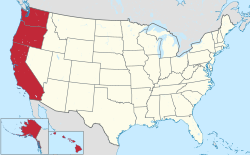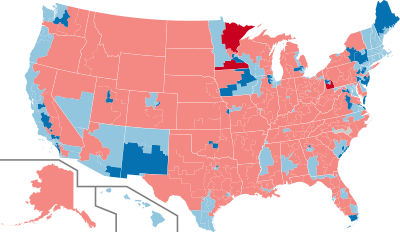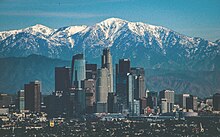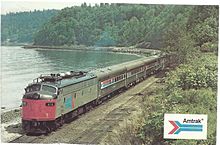geo.wikisort.org - Coast
The West Coast of the United States, also known as the Pacific Coast, Pacific states, and the western seaboard, is the coastline along which the Western United States meets the North Pacific Ocean. The term typically refers to the contiguous U.S. states of California, Oregon, and Washington, but sometimes includes Alaska and Hawaii, especially by the United States Census Bureau as a U.S. geographic division.
West Coast of the United States | |
|---|---|
Coastline | |
 Location of the West Coast (red) as defined by the Census Bureau.in the United States (tan) | |
| Country | |
| Principal cities | Los Angeles San Diego San Jose San Francisco Sacramento Portland Seattle Anchorage Honolulu |
| Largest city | Los Angeles |
| Largest metropolitan area | Greater Los Angeles |
| Area | |
| • Total | 1,009,688 sq mi (2,615,080 km2) |
| • Land | 895,287 sq mi (2,318,780 km2) |
| • Water | 21,433 sq mi (55,510 km2) |
| • Coastal | 28,913 sq mi (74,880 km2) |
| Highest elevation (Denali) | 20,310 ft (6,190.5 m) |
| Lowest elevation | −282 ft (−86 m) |
| Population (2020) | |
| • Total | 53,669,422[lower-alpha 1] |
| Time zone | |
| Mountain | UTC−7:00 |
| • Summer (DST) | UTC−6:00 |
| Pacific | UTC−8:00 |
| • Summer (DST) | UTC−7:00 |
| Alaska | UTC−9:00 |
| • Summer (DST) | UTC−8:00 |
| Hawaii | UTC−10:00 |
With the exception of Alaska, the Democratic Party has dominated West Coast politics in contemporary history, with the states consistently voting for Democrats in elections at various levels. Four out of five West Coast states have voted for Democrats in presidential elections since 1992, three of which have done so since 1988.
Definition
There are conflicting definitions of which states comprise the West Coast of the United States, but the West Coast always includes California, Oregon, and Washington as part of that definition. Under most circumstances, however, the term encompasses the three contiguous states and Alaska, as they are all located in North America. For census purposes, Hawaii is part of the West Coast, along with the other four states.[3] Encyclopædia Britannica refers to the North American region as part of the Pacific Coast, including Alaska and British Columbia. Although the encyclopedia acknowledges the inclusion of Hawaii in some capacity as part of the region, the editors wrote that "it has little in common geologically with the mainland states."[4]
Several dictionaries offer different definitions of the West Coast. Lexico restricts the West Coast's definition to "the western seaboard of the U.S. from Washington to California."[5] However, Macmillan Dictionary provides a less specific definition as "the western coast of the U.S., along the Pacific Ocean."[6] As for the Cambridge Dictionary, the West Coast is "the area of the Pacific coast in the U.S. that includes California."[7]
History
The history of the West Coast begins with the arrival of the earliest known humans of the Americas, Paleo-Indians, crossing the Bering Strait from Eurasia into North America over a land bridge, Beringia, that existed between 45,000 BCE and 12,000 BCE (47,000–14,000 years ago). Small isolated groups of hunter-gatherers migrated alongside herds of large herbivores far into Alaska. Between 16,500 BCE and 13,500 BCE (18,500–15,500 years ago), ice-free corridors developed along the Pacific coast and valleys of North America and possibly by sea.[8]
Alaska Natives, indigenous peoples of the Pacific Northwest Coast, and California indigenous peoples eventually descended from the Paleo-Indians. They developed various languages and established trade routes.[citation needed]
Later, Spanish, British, French, Russian, and American explorers and settlers began colonizing the area.[citation needed]

On May 10, 1869 the first transcontinental railroad was completed joining the West Coast to the East of the United States.
Climate
The West Coast of the United States has an oceanic climate in its Northwestern, Northern, and Eastern edge towards the U.S.-Canada border, but from Northern California, towards the U.S.-Mexico border the climate is mediterranean. While the northern half of the west coast, particularly coastal Washington and Oregon has moderate rainfall, particularly during the winter months, much of coastal California is drier year-round. The coastline sees significantly mild temperatures when compared to the inland areas during summer. In far Northern California there is a difference of 17 °C (30 °F) between Eureka and Willow Creek in spite of only 25 miles (40 km) separating the locations and Willow Creek being located at a 500 metres (1,600 ft) elevation. Slightly narrower fluctuations can be seen all through the coastline, and could partially be explained by the cold currents in the Pacific Ocean moderating coastal temperatures and the mountain ranges blocking the maritime air from moving farther inland than its foothills during summer. Coastal fog is also prevalent in keeping shoreline temperatures cool. While famous in the San Francisco Bay Area, coastal fog also affects Santa Monica in Los Angeles, Southern California, leading to May gray and June gloom conditions. Coastal California has very little yearly temperature differences with cool summers similar to those expected in parts of Northern Europe in San Francisco but warmer temperatures year-round further south. A short journey inland and summer temperatures are comparable with the rest of the United States on the same latitudes, sometimes warmer due to prevailing winds from the Nevada and Arizona hot desert climate. Humidity is far lower on the west coast compared to the eastern seaboard and thunderstorms are uncommon. [citation needed]
Government and politics
State governments
| State | Governor | Party | Term | ||
|---|---|---|---|---|---|
| Start | End | ||||
Mike Dunleavy |
Republican | December 3, 2018 | 2022 | ||
| Gavin Newsom | Democratic | January 7, 2019 | 2023 | ||
David Ige |
Democratic | December 1, 2014 | 2022 | ||
Oregon |
Kate Brown |
Democratic | February 18, 2015 | 2023 | |
Jay Inslee |
Democratic | January 16, 2013 | 2025 | ||
Ideology and party strength
In politics, the West Coast usually refers to the contiguous coastal states of California, Oregon, and Washington because of their similar political leanings. In 2017, The Oregonian columnist David Sarasohn described the West Coast as a "blue wall" of shared values on immigration, abortion, climate change, and civil liberties.[9] By 2016, the West Coast states legalized marijuana after California voted to do so.[10] According to a 2019 Pew Research Center poll, 72% of adults in Pacific states said that "climate change is affecting their local community at least some", higher than in any other region in the country.[11]
Since 1992, the three states have voted for Democrats in presidential elections without interruption, but Oregon and Washington also voted for the Democratic presidential candidate in 1988.[12] Although the three states have reliably voted Democratic, no Democratic presidential candidate from any of the three states has won their party's nomination as of 2020.[13]

In the 2010s, Democrats strengthened their political power along the West Coast. After winning a special election for a seat in the Washington state senate in 2017, Democrats built a government trifecta in all three West Coast states.[14] After the 2018 U.S. House of Representatives elections, Democrats controlled all West Coast congressional districts except Washington's 3rd, represented by a Republican.[15]
Even though Hawaii is not usually part of the West Coast in the political definition, it has been a Democratic stronghold. Before achieving statehood in 1959, Hawaii became a state favorable to Democrats to the point that they sought statehood for the territory. However, Southern Democrats opposed the move because it would mean additional votes against their region on several issues.[16] Since achieving statehood, Hawaii consistently voted for Democrats in presidential elections, except in 1972 and 1984.[17] In 2016, the Democratic Party unseated the lone Republican in the Hawaii Senate and controlled all seats in the state's upper house, which had not occurred anywhere in the country since 1980.[18]
Dissimilar to the rest of the West Coast, Alaska has been a reliable state for Republicans in presidential elections. Since achieving statehood, Alaska has voted for the Democratic presidential candidate only once in 1964. In 1960, the state narrowly voted for Republican Richard Nixon over Democrat John F. Kennedy and had voted for Republicans uninterrupted since 1968.[19]
Presidential election history
| Parties | ||
| Democratic | Republican | Progressive |
- Bold denotes election winner
| Year | Alaska[20] | California[21] | Hawaii[22] | Oregon[23] | Washington[24] |
|---|---|---|---|---|---|
| 1852 | No election | Pierce | No election | No election | No election |
| 1856 | No election | Buchanan | No election | No election | No election |
| 1860 | No election | Lincoln | No election | Lincoln | No election |
| 1864 | No election | Lincoln | No election | Lincoln | No election |
| 1868 | No election | Grant | No election | Seymour | No election |
| 1872 | No election | Grant | No election | Grant | No election |
| 1876 | No election | Hayes | No election | Hayes | No election |
| 1880 | No election | Hancock | No election | Garfield | No election |
| 1884 | No election | Blaine | No election | Blaine | No election |
| 1888 | No election | Harrison | No election | Harrison | No election |
| 1892 | No election | Cleveland | No election | Harrison | Harrison |
| 1896 | No election | McKinley | No election | McKinley | Bryan |
| 1900 | No election | McKinley | No election | McKinley | McKinley |
| 1904 | No election | Roosevelt | No election | Roosevelt | Roosevelt |
| 1908 | No election | Taft | No election | Taft | Taft |
| 1912 | No election | Roosevelt | No election | Wilson | Roosevelt |
| 1916 | No election | Wilson | No election | Hughes | Wilson |
| 1920 | No election | Harding | No election | Harding | Harding |
| 1924 | No election | Coolidge | No election | Coolidge | Coolidge |
| 1928 | No election | Hoover | No election | Hoover | Hoover |
| 1932 | No election | Roosevelt | No election | Roosevelt | Roosevelt |
| 1936 | No election | Roosevelt | No election | Roosevelt | Roosevelt |
| 1940 | No election | Roosevelt | No election | Roosevelt | Roosevelt |
| 1944 | No election | Roosevelt | No election | Roosevelt | Roosevelt |
| 1948 | No election | Truman | No election | Dewey | Truman |
| 1952 | No election | Eisenhower | No election | Eisenhower | Eisenhower |
| 1956 | No election | Eisenhower | No election | Eisenhower | Eisenhower |
| 1960 | Nixon | Nixon | Kennedy | Nixon | Nixon |
| 1964 | Johnson | Johnson | Johnson | Johnson | Johnson |
| 1968 | Nixon | Nixon | Humphrey | Nixon | Humphrey |
| 1972 | Nixon | Nixon | Nixon | Nixon | Nixon |
| 1976 | Ford | Ford | Carter | Ford | Ford |
| 1980 | Reagan | Reagan | Carter | Reagan | Reagan |
| 1984 | Reagan | Reagan | Reagan | Reagan | Reagan |
| 1988 | Bush | Bush | Dukakis | Dukakis | Dukakis |
| 1992 | Bush | Clinton | Clinton | Clinton | Clinton |
| 1996 | Dole | Clinton | Clinton | Clinton | Clinton |
| 2000 | Bush | Gore | Gore | Gore | Gore |
| 2004 | Bush | Kerry | Kerry | Kerry | Kerry |
| 2008 | McCain | Obama | Obama | Obama | Obama |
| 2012 | Romney | Obama | Obama | Obama | Obama |
| 2016 | Trump | Clinton | Clinton | Clinton | Clinton |
| 2020 | Trump | Biden | Biden | Biden | Biden |
| Year | Alaska | California | Hawaii | Oregon | Washington |
Demographics
| Historical population | |||
|---|---|---|---|
| Census | Pop. | %± | |
| 1900 | 2,634,285 | — | |
| 1910 | 4,448,534 | 68.9% | |
| 1920 | 5,877,788 | 32.1% | |
| 1930 | 8,622,011 | 46.7% | |
| 1940 | 10,228,556 | 18.6% | |
| 1950 | 15,114,964 | 47.8% | |
| 1960 | 21,198,044 | 40.2% | |
| 1970 | 26,524,131 | 25.1% | |
| 1980 | 31,799,705 | 19.9% | |
| 1990 | 39,127,306 | 23.0% | |
| 2000 | 45,025,637 | 15.1% | |
| 2010 | 49,880,102 | 10.8% | |
| 2020 | 53,669,422 | 7.6% | |
| Source: 1910–2020[25] | |||

According to the results of the 2020 United States Census, 16 of the 20 largest cities on the West Coast exist in California. Los Angeles, San Diego, and San Jose, all among the top 10 most populous cities in the country, lead the West Coast in population with more than a million people in each city, with Los Angeles being nearly three times the size of San Diego's population. Behind these three cities, San Francisco, Seattle and Portland are respectively fourth, fifth and sixth in population. Hawaii's capital and largest city, Honolulu, is the 13th largest city, and Alaska's largest city, Anchorage, is 17th on the West Coast.[26]
| City | City Population (2020) |
|---|---|
 Los Angeles |
3,898,747 |
 San Diego |
1,386,932 |
San Jose |
1,013,240 |
 San Francisco |
873,965 |
 Seattle |
737,015 |
Portland |
652,503 |
Fresno |
542,107 |
Sacramento |
524,943 |
 Long Beach |
466,742 |
 Oakland |
440,646 |
Culture
Since the West Coast has been populated by immigrants and their descendants more recently than the East Coast, its culture is considerably younger. Additionally, its demographic composition underlies its cultural difference from the rest of the United States. California's history first as a major Spanish colony, and later Mexican territory, has given the lower West Coast a distinctive Hispanic American tone, which it also shares with the rest of the Southwest. Similarly, two of the three cities in which Asian Americans have concentrated, San Francisco and Los Angeles,[32][33][34] are located on the West Coast, with significant populations in other West Coast cities. San Francisco's Chinatown, the oldest in North America, is a noted cultural center.
The West Coast also has a proportionally large share of green cities within the United States, which manifests itself in different cultural practices such as bicycling and organic gardening.[35]
In the Pacific Northwest, Portland and Seattle are both considered among the coffee capitals of the world.[36] While Starbucks originated in Seattle, both cities are known for small-scale coffee roasters and independent coffeeshops. The culture has also been significantly shaped by the environment, especially by its forests, mountains, and rain. This may account for the fact that the Northwest has many high-quality libraries and bookshops (most notably Powell's Books and the Seattle Central Library) and a "bibliophile soul".[37] The region also has a marginal, but growing independence movement based on bioregionalism and a Cascadian identity.[38] The Cascadian flag has become a popular image at Seattle Sounders FC and Portland Timbers games.[citation needed]
Alaska is widely known for its outdoors and its inhabitants engage in a range of activities that are unique to the state. Some of these activities can be experienced through the state's annual events, such as the Iron Dog snowmobile race from Anchorage to Nome and on to Fairbanks. Other events include the World Ice Art Championships (Fairbanks) and the Sitka Whalefest (Sitka).[citation needed]
Transportation

Coast Starlight is the main interstate passenger railroad route provided by Amtrak. Interstate railroad tracks in the Western United States are provided by Union Pacific Railroad. Interstate travel is also served by roads such as the Interstate 5 freeway and the scenic tourism route, the Pacific Highway (United States). Sierra High Route is a popular trekking route.
See also
- British Columbia Coast
- East Coast of the United States
- East Coast–West Coast hip hop rivalry
- Gulf Coast of the United States
- Pacific Coast of Mexico
- Southern California Bight
- Sun Belt
- Third Coast
Notes
- The population total consists of the combined population of Alaska, California, Hawaii, Oregon, and Washington, according to the 2020 United States census.[2]
References
- "Highest and Lowest Elevations". United States Geological Survey. Retrieved April 29, 2021.
- "Change in Resident Population of the 50 States, the District of Columbia, and Puerto Rico: 1910 to 2020" (PDF). United States Census Bureau. Retrieved 13 June 2021.
- Kiprop, Victor (11 January 2019). "Which States Are on the West Coast?". World Atlas. Archived from the original on 25 September 2020. Retrieved 13 November 2020.
- "Pacific Coast". Encyclopædia Britannica. 28 December 2015. Archived from the original on 30 October 2020. Retrieved 14 November 2020.
- "West Coast". Lexico. Oxford University Press. Archived from the original on November 13, 2020. Retrieved 13 November 2020.
- "the West Coast". Macmillan Dictionary. Macmillan Education. Archived from the original on 26 August 2019. Retrieved 13 November 2020.
- "the West Coast". Cambridge Dictionary. Cambridge University Press. Archived from the original on 23 August 2019. Retrieved 13 November 2020.
- "First Americans Endured 20,000-Year Layover – Jennifer Viegas, Discovery News". Retrieved 2009-11-18.
Archaeological evidence, in fact, recognizes that people started to leave Beringia for the New World around 40,000 years ago, but rapid expansion into North America did not occur until about 15,000 years ago, when the ice had literally broken.
- Sarasohn, David (3 December 2017). "David Sarasohn: Trump batters against West coast blue wall". The Oregonian. Archived from the original on 14 November 2017. Retrieved 14 November 2020.
- Fuller, Thomas; Healy, Jack; Johnson, Kirk (11 November 2016). "Amid Tide of Red on Electoral Map, West Coast Stays Defiantly Blue". The New York Times. San Francisco. Archived from the original on 8 November 2020. Retrieved 14 November 2020.
- Hefferon, Meg (2 December 2019). "Most Americans say climate change impacts their community, but effects vary by region". Pew Research Center. Archived from the original on 1 October 2020. Retrieved 14 November 2020.
- Monkovic, Toni (22 August 2016). "50 Years of Electoral College Maps: How the U.S. Turned Red and Blue". The New York Times. Archived from the original on 8 November 2020. Retrieved 13 November 2020.
- Sarasohn, David (26 September 2018). "The Rise of West Coast Democrats". The New Republic. Archived from the original on 9 November 2020. Retrieved 13 November 2020.
- Weigel, David (9 November 2017). "Democrats now control all branches of state government along the West Coast". The Washington Post. Archived from the original on 26 September 2018. Retrieved 13 November 2020.
- Bump, Philip (12 November 2018). "With the exception of 38 miles in Washington, the entire continental West Coast is now blue". The Washington Post. Archived from the original on 8 November 2020. Retrieved 13 November 2020.
- Sprunt, Barbara (21 August 2020). "Simmering Disputes Over Statehood Are About Politics And Race. They Always Have Been". NPR News. Retrieved 13 November 2020.
- Eagle, Nathan (7 August 2018). "The Hawaii Republican Party's Slow Path To Extinction". Honolulu Civil Beat. Archived from the original on 9 November 2020. Retrieved 13 November 2020.
- Bussewitz, Cathy (9 November 2016). "Chang wins seat, securing all-Democrat Hawaii Senate". Associated Press. Archived from the original on 13 November 2020. Retrieved 13 November 2020.
- Martinson, Erica (5 November 2016). "Alaska has a long history of voting strongly Republican for president. Will it continue?". Anchorage Daily News. Archived from the original on 4 August 2020. Retrieved 14 November 2020.
- "Alaska Presidential Election Voting History". 270 To Win. Retrieved 2020-11-22.
- "California Presidential Election Voting History". 270 To Win. Retrieved 2020-11-22.
- "Hawaii Presidential Election Voting History". 270 To Win. Retrieved 2020-11-22.
- "Oregon Presidential Election Voting History". 270 To Win. Retrieved 2020-11-22.
- "Washington Presidential Election Voting History". 270 To Win. Retrieved 2020-11-22.
- "Change in Resident Population of the 50 States, the District of Columbia, and Puerto Rico: 1910 to 2020" (PDF). United States Census Bureau. Retrieved 13 June 2021.
- "Annual Estimates of the Resident Population for Incorporated Places of 50,000 or More, Ranked by July 1, 2019". United States Census Bureau. Retrieved 14 November 2020.
- "U.S. Census". United States Census Bureau. Retrieved 2020-03-16.
- "U.S. Census Region Map". 2000-08-17. Archived from the original on 2000-08-17. Retrieved 2020-03-16.
- "California Cities by Population". www.california-demographics.com. Retrieved 2020-03-16.
- "Oregon Cities by Population". www.oregon-demographics.com. Retrieved 2020-03-16.
- "Washington Cities by Population". www.washington-demographics.com. Retrieved 2020-03-16.
- "Selected Population Profile in the United States". United States Census Bureau. United States Department of Commerce. Archived from the original on February 12, 2020. Retrieved June 25, 2011.
- Lee, Sharon M. (1998). "Asian Americans: Diverse and Growing" (PDF). Population Bulletin. Population Reference Bureau. 53 (2): 1–40. PMID 12321628. Retrieved March 9, 2013.
- Ng, Franklin (1998). The History and Immigration of Asian Americans. Taylor & Francis. p. 211. ISBN 978-0-8153-2690-8. Retrieved March 9, 2013.
- "Top ten green U.S. cities". Mother Nature Network. Retrieved June 26, 2014.
- "World's 10 best cities for coffee". USA Today. Retrieved February 22, 2015.
- "Pacific Northwest: bicycles, bookshops, weirdness, and coffee". The Guardian. Retrieved February 22, 2015.
- "The People Who Wouldn't Mind if the Pacific Northwest Were Its Own Country". Vice. Retrieved February 22, 2015.
Другой контент может иметь иную лицензию. Перед использованием материалов сайта WikiSort.org внимательно изучите правила лицензирования конкретных элементов наполнения сайта.
WikiSort.org - проект по пересортировке и дополнению контента Википедии